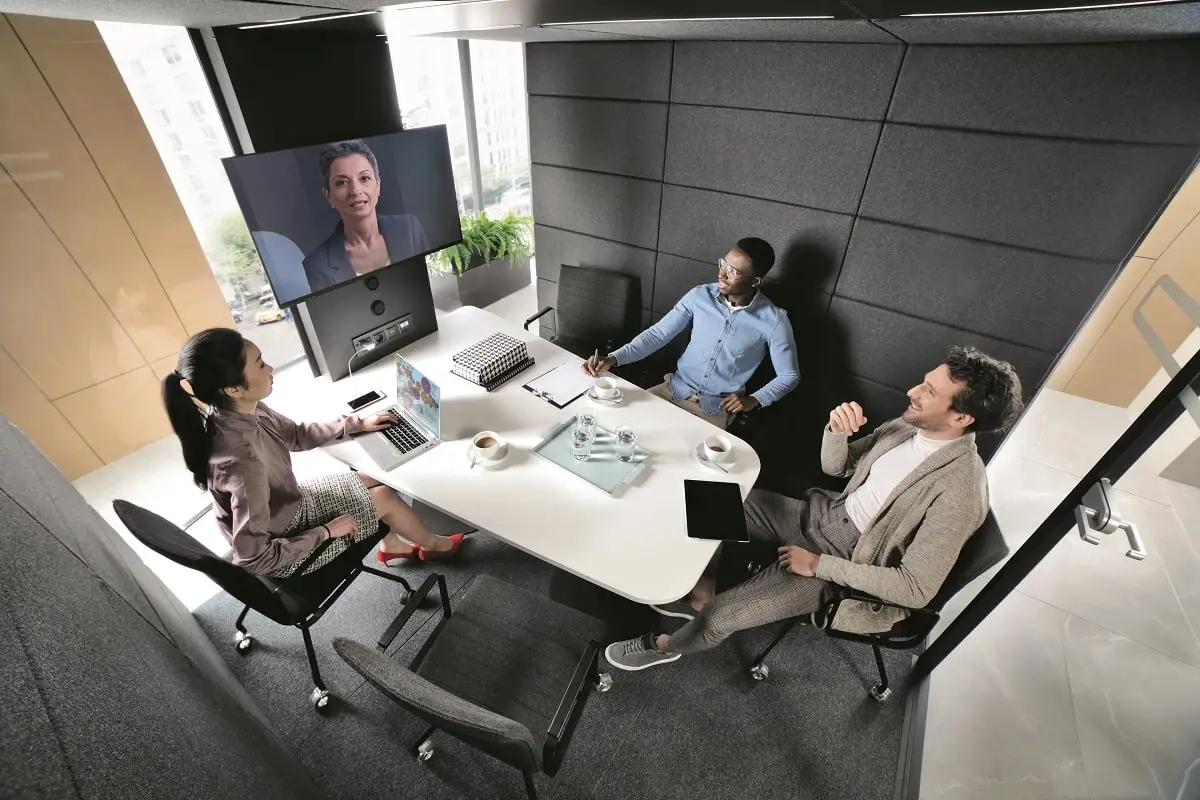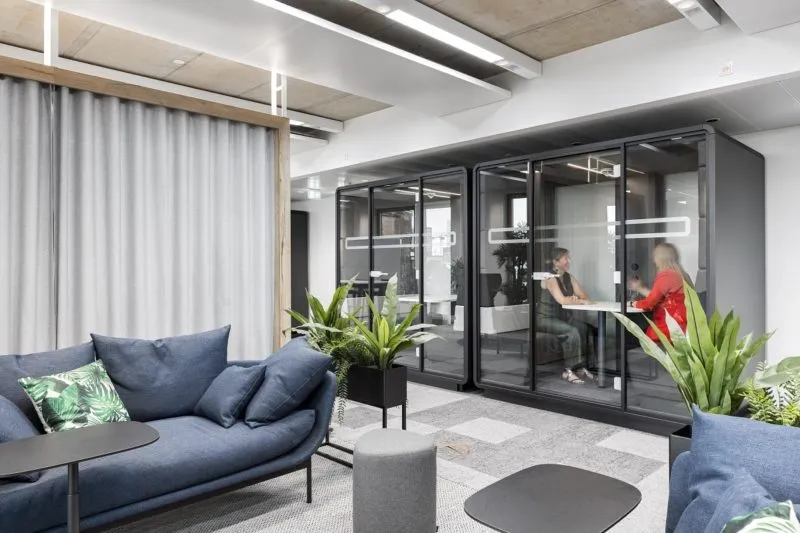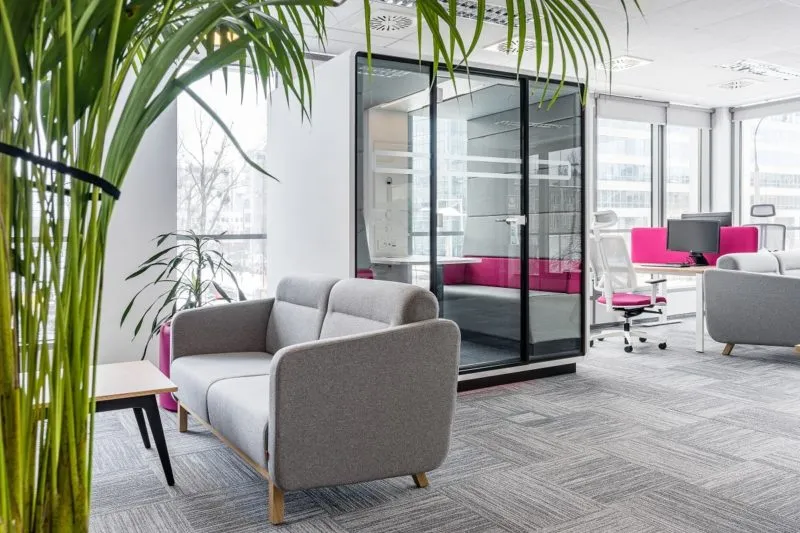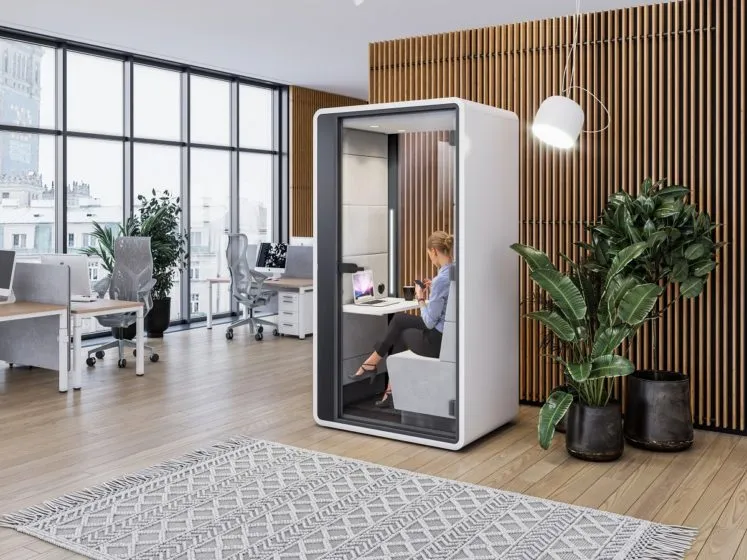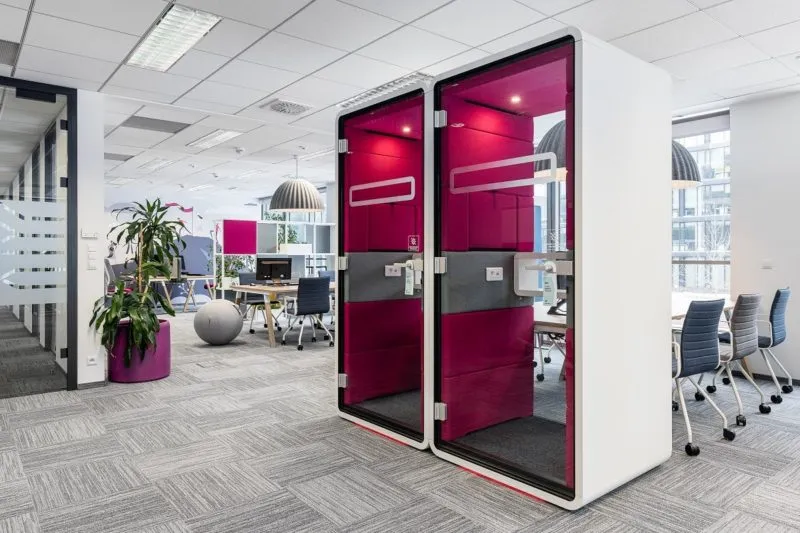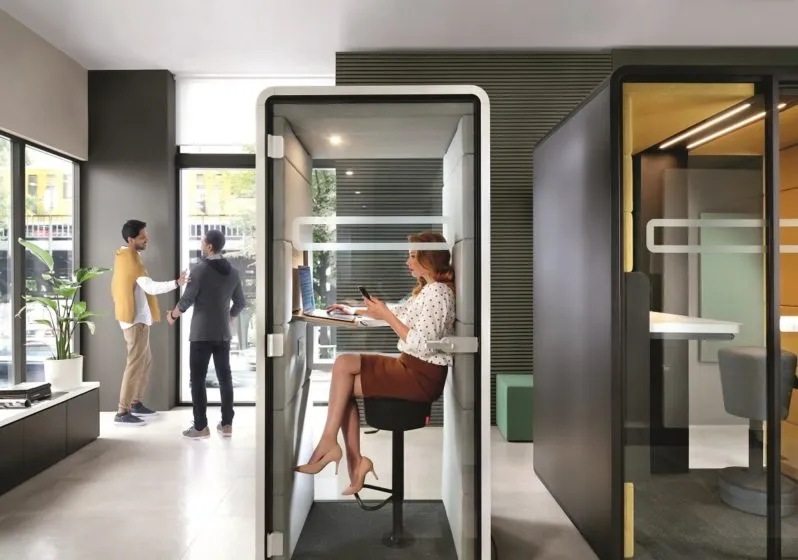Boost mental health through a well-zoned activity based workplace
- Posted on: 9 December 2023
- By: Hushoffice Team
An activity-based workplace, properly divided, can better a team’s morale. The right balance of “open” and “closed” is vital. Approached with universal design principles top of mind, too, performance gains are sure to follow. Let’s take a look at the research.
tl;dr – boosting mental health in a perfectly zoned activity-based office
A rich variety of zones is the crux of an inclusive, ABW workplace. And though switching up work locations does benefit performance and creativity, there is a caveat: privacy is paramount. In fact, an employee’s main criteria for choosing a workspace in an activity-based layout regards privacy. Of course, privacy is inextricably linked with wellness.
Personal control is the second liberty an ABW office must give to satisfy employees, neurotypical and neurodivergent alike. Personal control is actually one of the most influential factors for occupant satisfaction. This is no wonder – a lack of control is stressful for anyone. Contrarily, personal control relieves stress, befitting mental wellness.
Thermal comfort and acoustics benefit all employees regardless of their cognitive wiring. So to promote the best mental state of its occupants, an activity-based workplace should give control over temperature and noise levels, in particular. Hushoffice pods and booths are strong solutions because they offer adjustability over such basic aspects including ventilation, lighting, noise, and privacy.
How does the physical work environment affect employee health?
Businesses must take their offices into account, for a well-thought-out workplace can shape a more peaceful and productive atmosphere. Ultimately, people that feel comfortable and calm in the office will do their best work.
Stress, fatigue, and a fast pace of work — professional everyday life for many.
Sadly enough, as a reference point, 83% of US workers suffer from work-related stress, with 25% saying their job is the number one stressor in their lives. What’s more, over two-thirds of employees feel tired during the workday.
Fatigue is a cognitive impairment. It hinders attention, memory, and impulse control.
This explains why tired workers are 6% less productive. Fatigue in the workplace actually costs U.S. companies $136 billion each year in health-related lost productivity. Just a single employee with daily fatigue can cost an employer $3,500 a year in absenteeism, healthcare costs, and lost output.
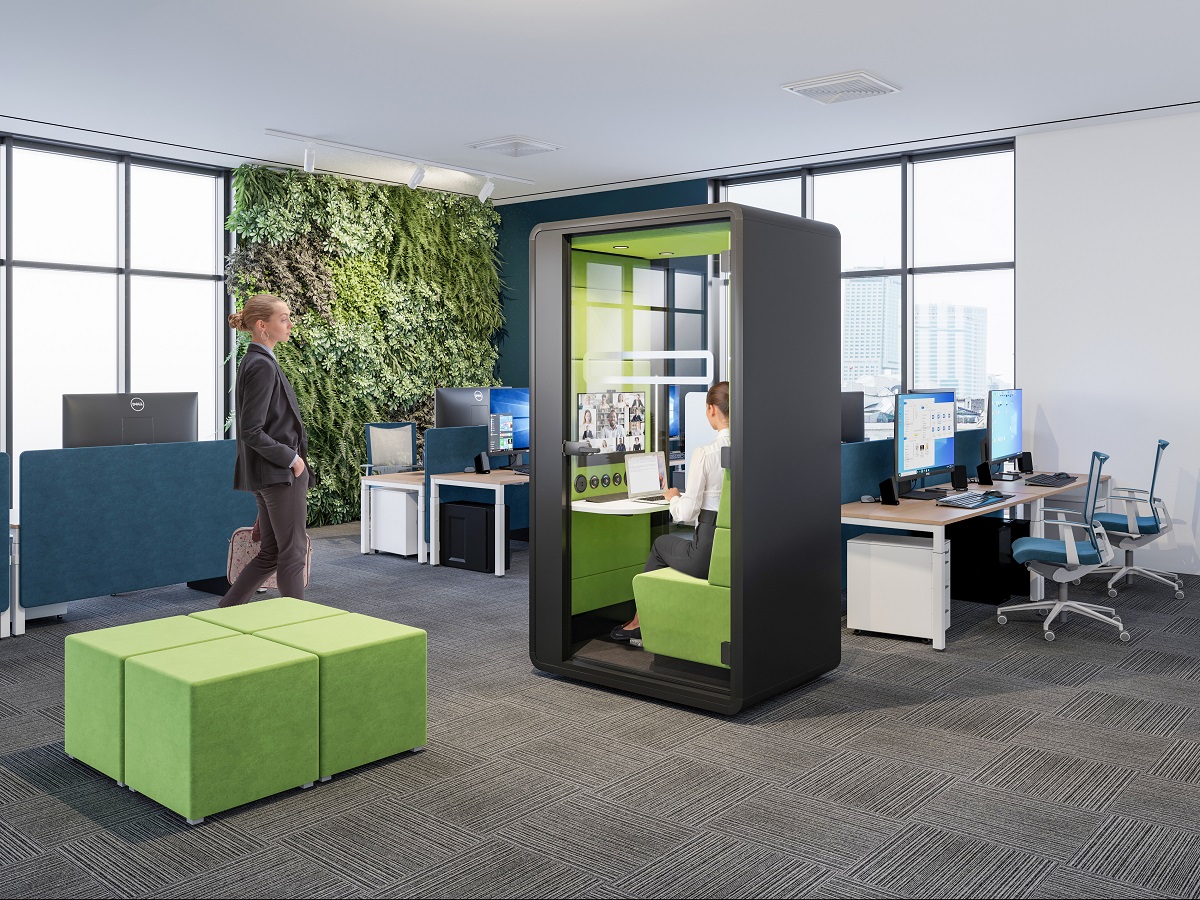
Can the workplace improve the mental health of employees?
Most certainly. A workspace’s colors, alone, have a profound effect on employee mood. And when it comes to stimuli, for instance, a private work booth like hushHybrid is at-hand stress relief for employees who are sensory-avoidant.
Research carried out by the World Green Building Council found an 11% increase in productivity as a result of improved fresh air to workstations and a reduction in pollutants
A study conducted by the Department of Design and Environmental Analysis at Cornell showed that employees seated within 10 feet of a window report a 84% decrease in eyestrain, headaches, and blurred vision symptoms
Research from Public Health England revealed that the more personal control employees have over their work environment, along with easy access to meeting places, the more satisfied they are with their job and the higher their perception of group cohesiveness
The working environment is just as important as the work at hand.
The office space sets the tone for smooth performance. When well-designed, it makes every operation work better. As discovered in this article, good lighting, comfortable furniture, and an organized setup are essential.
Different people, different needs; universal design (UD) is for all.
Also called “inclusive design,” UD ensures the accessibility of any built environment. An inclusive office accommodates all needs and neurology. And “if you do not intentionally, deliberately and proactively include, you will unintentionally exclude,” says Jean-Baptiste.
Universal design principles are good ones to rely on because they embrace the focus and well-being of every class of employee, from those with attention troubles to those who are extremely extroverted. They call for a few things. First, structures and spaces must cater to a range of abilities. Every structure and space must also be easy and intuitive to use, broadcasting necessary information clearly regardless of sensory abilities. The chance for user error must be eliminated and the support of different body sizes, postures and mobility ensured. In short, the space works for everyone
– says Mateusz Barczyk, Senior Brand Manager, Hushoffice.
One in seven people are neurodivergent.
Naturally, to foster the success of all employee types through the office (including the neurodivergent), it is vital to work with employees directly. Then, individual needs can be understood for creative, totally inclusive solutions to be identified.
Read: Office design for neurodiverse workforce
Arguably, inclusive design is critical to workplace innovation.
After all, bringing together many perspectives makes for better problem-solving. Moreover, you need diversity on your team to stay relevant in an increasingly diverse world.
What factors should be included in the pursuit of universal office design?
Environmental and spatial factors, first and foremost. For instance, some employees are extra sensitive to noise, light, and air pollutants. And across the board, sit-stand desks, light and temperature control, rec rooms for socialization, and quiet zones are foundations of an inclusive workplace.
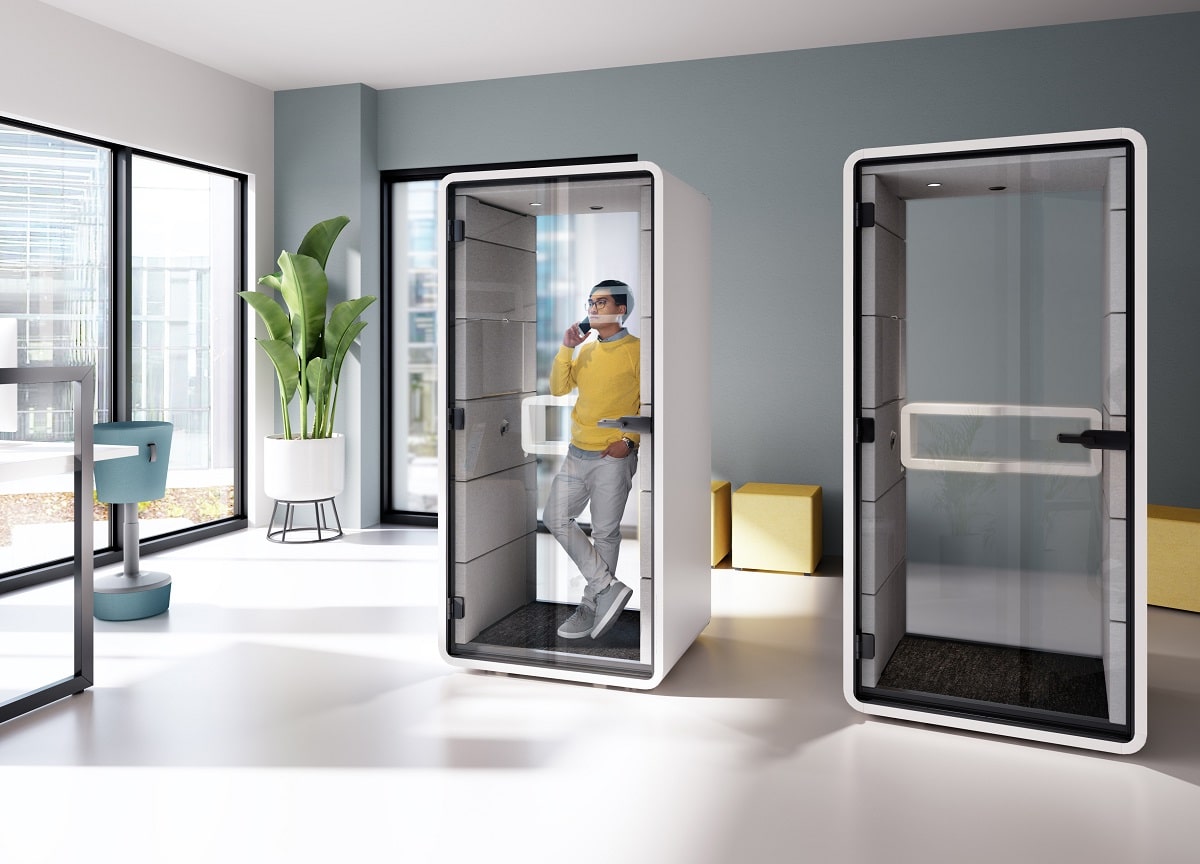
Lighting and furniture choices can make or break an office’s accessibility.
Interestingly, furniture ergonomics and lighting make the greatest contribution to the wellbeing of a neurodiverse workforce. So the choices between fluorescent-overhead and adjustable task lighting, or cushy, unsupportive swivel chairs and structured sit-stand seating, are highly consequential.
A recent survey compared the needs of neurodivergent to neurotypical employees. It offers helpful direction on retrofitting your office for better accessibility. Room decor and layout apparently have marked positive correlations with creativity in the neurodiverse, specifically. Thermal comfort and acoustics, meanwhile, benefit all employees regardless of their cognitive wiring. But most notably, the big thing informing workplace satisfaction across both types of employees is actually personal control. This finding makes us very pleased to present our Hushoffice booths which give the user control over lighting, ventilation, privacy, and acoustics
– lends Mateusz Barczyk, Senior Brand Manager, Hushoffice.
Working well — design with flexibility in mind.
When planning a flexible work environment, privacy and noise levels are known critical factors which any workspace planner recognizes. But rounding out the list is a fourth factor sometimes overlooked, corroborated by research just mentioned: personal or individual control.
Greenery in the office is a boost to soothe the senses.
Nature decreases stress. And even short virtual nature breaks – isolating in a private space like a pod and getting lost in birdsong or waterfall footage for 15 minutes – can greatly reduce negative emotions and anxiety while increasing parasympathetic nervous activity (which relaxes the body).
Employee-friendly open space, i.e. divided into zones.
Smart, creative zoning (or space division), produces a smart, creative workplace. The following conclusions from a 2023 case study on three activity-based flexible office layouts may be helpful for anyone thinking over the ABW way:
Zone variation is the essence of an activity-based office. Clear design cues, spatial seclusion, and soundproofing help. They create the comprehensible environment desired in which employees easily read, understand, and occupy their office’s zones most efficiently.
“Deficient zoning” is a problem. It means a disproportionate allocation of different types of zones and workstations paired with a poor balance between open, transparent zones and closed, private ones.
When an activity-based workplace is deficiently zoned, the readability of each zone is obscured. The office lacks intuitiveness. Employees meet stress and delay navigating their workplace. They are unable to interpret and distinguish the intended use of each zone.
Balance between concentration and teamwork must be struck.
Typically, an employee’s criteria for choosing a workstation in an ABW office regard privacy. This fact highlights something significant. To operate well, an activity-based workplace must have a balanced ratio of open to secluded work environments.
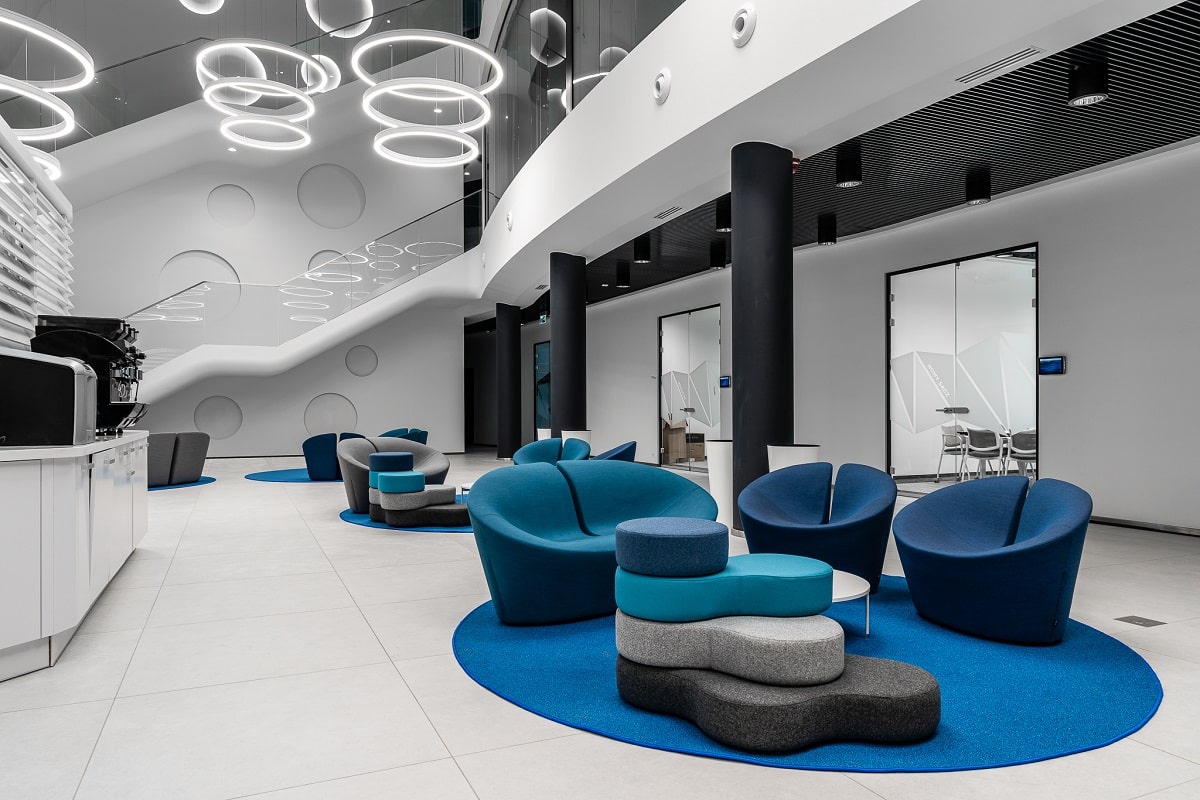
Flexibility and adaptability are imperative.
As noted, personal control is one of the most influential factors for user satisfaction and environmental comfort. In fact, a high degree of direct personal control contributes to more than 80% of an occupant’s satisfaction level.
Personal control can even mediate office distractions!
When employees can adjust aspects of their office work environment, enjoying personal control, the negative effects of distractions are actually diminished. So makes the case for office pods which afford control and block out distractions.
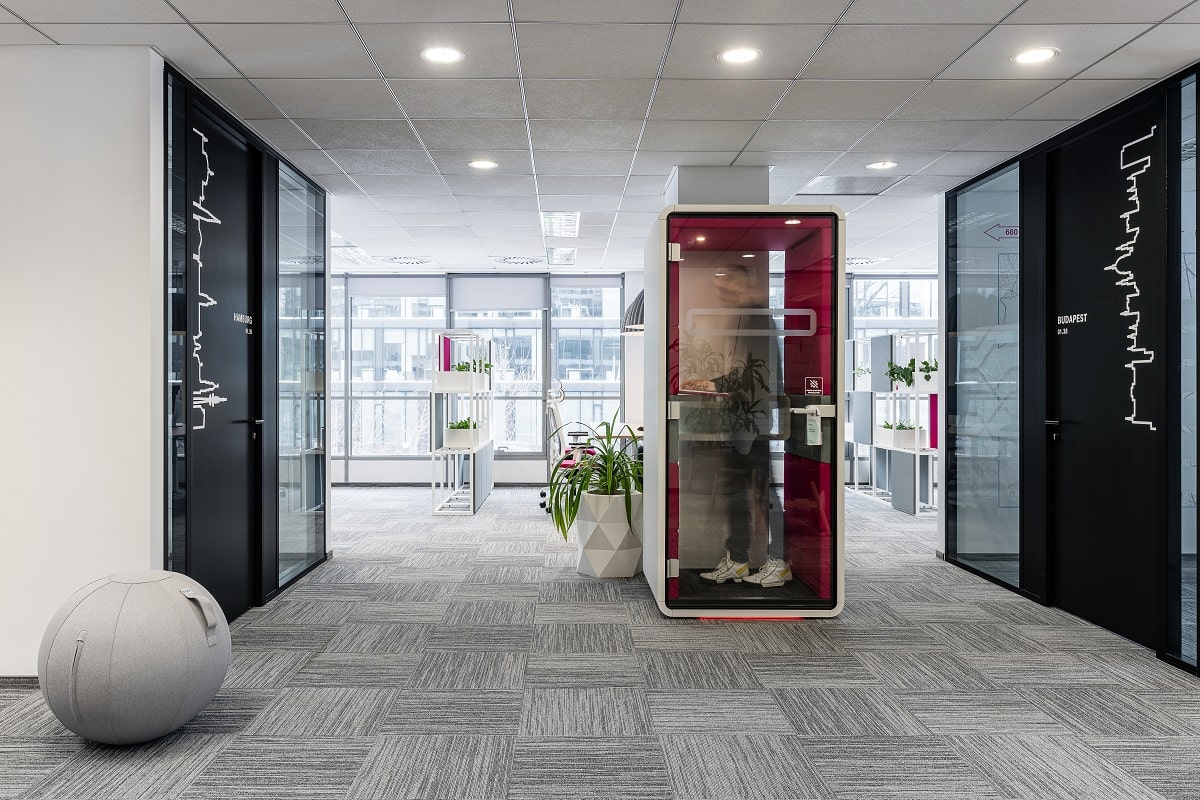
Employees need places for socialization
Casual chit-chat can be heartening, energizing, and thought-provoking. Office pods are a worthy support. They make keen conversion spaces. They are a convenient spot where peers can chat in private, having constructive discussions and improved work relations.
Read more: How “isolation” pods make the office more social, not less
Alternatives to working at a desk enhance output and thought processes.
Did you know that switching up work locations can benefit employee performance and creativity? It is indeed true, but hard research on the matter highlights a caveat. In an ABW office with employees changing work locations regularly, privacy is the key to success.
While communication and collaboration are high in ABW offices, the provision of privacy is often missing and always critical. With no doubt, solutions like acoustic baffles, sound-insulating space dividers, desktop privacy screens, and noise-blocking pods are the finishing, functional touches of any activity-based workplace. Such solutions give employees a healthy degree of personal space
– adds Mateusz Barczyk, Senior Brand Manager, Hushoffice.
Acoustic cabins. High-quality work and relaxation spaces that work for everyone.
Pods, booths, and cabins advance an activity-based office, giving it universal accessibility. They provide employees with a quiet environment where speech is secure. They provide the professional look expected of a premium meet space. And they are user-controllable.
HushAccess.L acoustic booth. A place to relax in the bustle of open space.
Employees need places to meet up without bothering others. HushAccess.L is this place. It is a large office work booth for gatherings of all sizes. It is offered with contemporary furniture or can be ordered empty for customers to furnish it how they like.
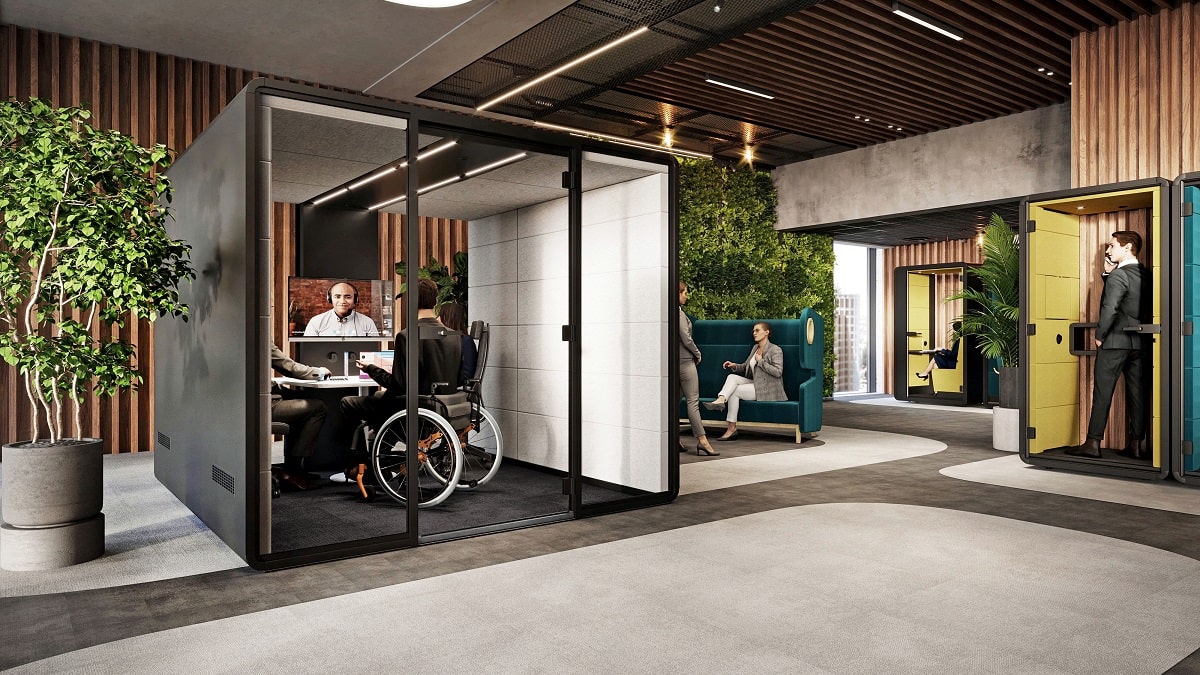
HushPhone. Privacy at your fingertips.
Every call deserves discretion. HushPhone is a single-person booth for truly private phone calls. It features premium upholstered interior panels, top-notch sound insulation, and a leaning armrest for long chats.
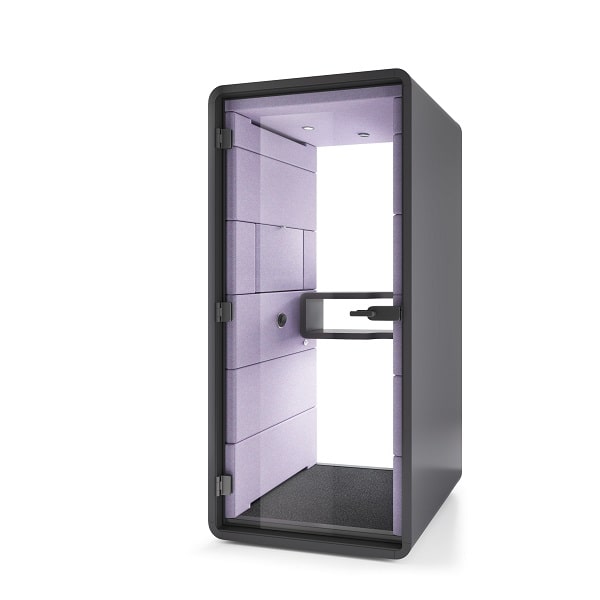
HushMeet. A place for creative thinking
Need isolation? HushMeet is a four-person meeting booth for you. It is furnished and finished for ultimate convenience. It is also mobile, allowing for quick relocation per emerging needs.
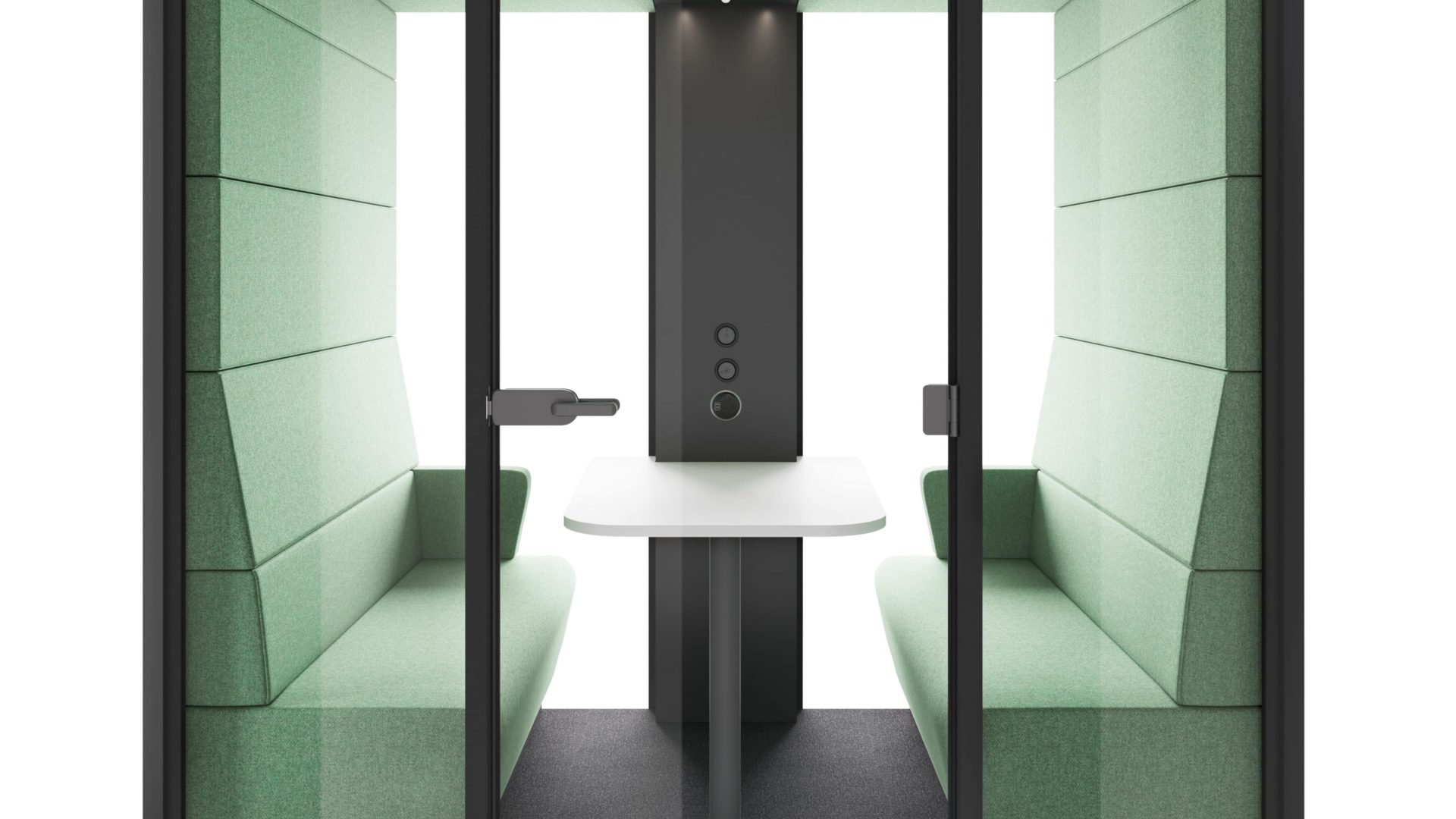
HushHybrid. Easy communication via video call.
Hybrid meetings have become the norm. HushHybrid is the one-person pod needed for easy video conferencing. It features extra LED light strips that illuminate the user’s face brightly, boosting cues to do with facial expressions.

Read: How to zone the office for hybrid work
Boosting mental health in a perfectly zoned activity-based office – summary
A rich variety of zones is the crux of an inclusive, ABW workplace. And though switching up work locations does benefit performance and creativity, there is a caveat: privacy is paramount. In fact, an employee’s main criteria for choosing a workspace in an activity-based layout regards privacy. Of course, privacy is inextricably linked with wellness.
Personal control is the second liberty an ABW office must give to satisfy employees, neurotypical and neurodivergent alike. Personal control is actually one of the most influential factors for occupant satisfaction. This is no wonder – a lack of control is stressful for anyone. Contrarily, personal control relieves stress, befitting mental wellness.
Thermal comfort and acoustics benefit all employees regardless of their cognitive wiring. So to promote the best mental state of its occupants, an activity-based workplace should give control over temperature and noise levels, in particular. Hushoffice pods and booths are strong solutions because they offer adjustability over such basic aspects including ventilation, lighting, noise, and privacy.
Activity based office for mental health – frequently asked questions
What office design is good for mental health?
An activity-based workplace, designed inclusively, with everyone in mind, stands as the best boost of mental wellness. This type of office is flexible and inclusive, allowing people to choose how they work best. Adjustable desks, a variety of seating options, and quiet areas make it comfortable for everyone.
How do office work pods support employee mental health?
Pods and cabins offer a unique blend of privacy, control, and flexibility, promoting mental wellness by a few simple measures. They block out sound, limiting one of the most upsetting forms of sensory overload in an open space office. They cocoon the user in a private, sovereign space, affording a sense of autonomy and control which benefits morale. And they allow teammates to converse or collaborate freely without worry of being listened to or judged by others.
What is the most significant factor influencing an employee’s satisfaction with their office space?
Interestingly, personal control is one of the most influential factors on occupant satisfaction. A high degree of direct personal control contributes to more than 80% of an employee’s satisfaction in the office. This is why sovereign, user-tweakable spaces such as office booths are worthy investments. They give employees control over lighting, ventilation, and acoustics.
